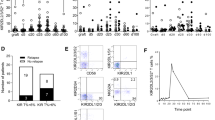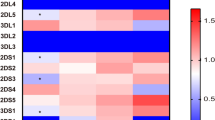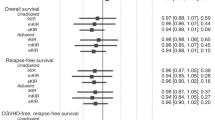Abstract
The role of killer Ig-like receptors (KIR) in SCT was analyzed. A total of 75 Chinese patients were transplanted with T-depleted hematopoietic stem cells from unrelated donors. Among the 75 donor–recipient pairs, 60 were HLA 10/10 matched and 15 had some mismatches at HLA-C. Transplants from KIR haplotype B/x group donors showed significantly higher overall survival rates compared with those from KIR haplotype A/A donors (relative risk (RR) 3.1 (95% confidence interval (CI) 1.1–8.6), P=0.007). In the haplotype A/A group, a higher risk of acute GVHD (aGVHD) (RR 9.0 (95% CI 1.2–66.9), P=0.01), especially grade III–IV aGVHD (P=0.006), was observed when the donor was homozygous for the full-length expressed KIR2DS4*00101 allele. Real-time PCR showed that a high expression of inhibitory KIR (2DL1 and 3DL1) in the early stages (<90 days) after transplantation correlated with the development of aGVHD (z=2.558, P=0.011). Our findings indicated a significant association of full-length KIR2DS4 or KIR2DL1/3DL1 expression with the occurrence of aGVHD. In aggregate these results suggested that combining KIR and HLA genotyping could help in the selection of transplant donors and improve the outcome of transplantation. Dynamic detection of KIR2DL1/3DL1 expression would be beneficial for prediction of aGVHD after transplantation.
This is a preview of subscription content, access via your institution
Access options
Subscribe to this journal
Receive 12 print issues and online access
$259.00 per year
only $21.58 per issue
Buy this article
- Purchase on Springer Link
- Instant access to full article PDF
Prices may be subject to local taxes which are calculated during checkout


Similar content being viewed by others
References
Ruggeri L, Capanni M, Casucci M, Volpi I, Tosti A, Perruccio K et al. Role of natural killer cell alloreactivity in HLA-mismatched hematopoietic stem cell transplantation. Blood 1999; 94: 333–339.
Ruggeri L, Capanni M, Urbani E, Perruccio K, Shlomchik WD, Tosti A et al. Effectiveness of donor natural killer cell alloreactivity in mismatched hematopoietic transplants. Science 2002; 295: 2097–2100.
Middleton D, Gonzalez A, Gilmore PM . Studies on the expression of the deleted KIR2DS4*003 gene product and distribution of KIR2DS4 deleted and nondeleted versions in different populations. Hum Immunol 2007; 68: 128–134.
Shilling HG, McQueen KL, Cheng NW, Shizuru JA, Negrin RS, Parham P . Reconstitution of NK cell receptor repertoire following HLA-matched hematopoietic cell transplantation. Blood 2003; 101: 3730–3740.
Shilling HG, Young N, Guethlein LA, Cheng NW, Gardiner CM, Tyan D et al. Genetic control of human NK cell repertoire. J Immunol 2002; 169: 239–247.
Hsu KC, Keever-Taylor CA, Wilton A, Pinto C, Heller G, Arkun K et al. Improved outcome in HLA-identical sibling hematopoietic stem-cell transplantation for acute myelogenous leukemia predicted by KIR and HLA genotypes. Blood 2005; 105: 4878–4884.
Miller JS, Cooley S, Parham P, Farag SS, Verneris MR, McQueen KL et al. Missing KIR ligands are associated with less relapse and increased graft-versus-host disease (GVHD) following unrelated donor allogeneic HCT. Blood 2007; 109: 5058–5061.
Chen C, Busson M, Rocha V, Appert ML, Lepage V, Dulphy N et al. Activating KIR genes are associated with CMV reactivation and survival after non-T-cell depleted HLA-identical sibling bone marrow transplantation for malignant disorders. Bone Marrow Transplant 2006; 38: 437–444.
Gagne K, Brizard G, Gueglio B, Milpied N, Herry P, Bonneville F et al. Relevance of KIR gene polymorphisms in bone marrow transplantation outcome. Hum Immunol 2002; 63: 271–280.
Malmberg KJ, Schaffer M, Ringden O, Remberger M, Ljunggren HG . KIR-ligand mismatch in allogeneic hematopoietic stem cell transplantation. Mol Immunol 2005; 42: 531–534.
Vampa ML, Norman PJ, Burnapp L, Vaughan RW, Sacks SH, Wong W . Natural killer-cell activity after human renal transplantation in relation to killer immunoglobulin-like receptors and human leukocyte antigen mismatch. Transplantation 2003; 76: 1220–1228.
Hou L, Steiner NK, Chen M, Belle I, Kubit AL, Ng J et al. Limited allelic diversity of stimulatory two-domain killer cell immunoglobulin-like receptors. Hum Immunol 2008; 69: 174–178.
Robinson J, Waller MJ, Stoehr P, Marsh SG . IPD--the Immuno Polymorphism Database. Nucleic Acids Res 2005; 33 (Database issue): D523–D526.
Valiante NM, Uhrberg M, Shilling HG, Lienert-Weidenbach K, Arnett KL, D’Andrea A et al. Functionally and structurally distinct NK cell receptor repertoires in the peripheral blood of two human donors. Immunity 1997; 7: 739–751.
Khakoo SI, Thio CL, Martin MP, Brooks CR, Gao X, Astemborski J et al. HLA and NK cell inhibitory receptor genes in resolving hepatitis C virus infection. Science 2004; 305: 872–874.
Cooley S, Xiao F, Pitt M, Gleason M, McCullar V, Bergemann TL et al. A subpopulation of human peripheral blood NK cells that lacks inhibitory receptors for self-MHC is developmentally immature. Blood 2007; 110: 578–586.
Bao XJ, He J, Chen ZX, Wu DP, Yao L, Yuan XN et al. Study on the behavior of NK cell KIRs of donor/recipient pairs in HLA matched unrelated allo-HSCT. Zhonghua Xue Ye Xue Za Zhi 2007; 28: 510–513.
Cooley S, Trachtenberg E, Bergemann TL, Saeteurn K, Klein J, Le CT et al. Donors with group B KIR haplotypes improve relapse-free survival after unrelated hematopoietic cell transplantation for acute myelogenous leukemia. Blood 2009; 113: 726–732.
Anfossi N, Andre P, Guia S, Falk CS, Roetynck S, Stewart CA et al. Human NK cell education by inhibitory receptors for MHC class I. Immunity 2006; 25: 331–342.
Kim S, Poursine-Laurent J, Truscott SM, Lybarger L, Song YJ, Yang L et al. Licensing of natural killer cells by host major histocompatibility complex class I molecules. Nature 2005; 436: 709–713.
Bryceson YT, March ME, Ljunggren HG, Long EO . Activation, coactivation, and costimulation of resting human natural killer cells. Immunol Rev 2006; 214: 73–91.
Vivier E, Nunes JA, Vely F . Natural killer cell signaling pathways. Science 2004; 306: 1517–1519.
Warren HS, Campbell AJ, Waldron JC, Lanier LL . Biphasic response of NK cells expressing both activating and inhibitory killer Ig-like receptors. Int Immunol 2001; 13: 1043–1052.
Murphy WJ, Kumar V, Bennett M . Rejection of bone marrow allografts by mice with severe combined immune deficiency (SCID). Evidence that natural killer cells can mediate the specificity of marrow graft rejection. J Exp Med 1987; 165: 1212–1217.
Ciccone E, Viale O, Pende D, Malnati M, Biassoni R, Melioli G et al. Specific lysis of allogeneic cells after activation of CD3- lymphocytes in mixed lymphocyte culture. J Exp Med 1988; 168: 2403–2408.
Campbell KS, Cella M, Carretero M, Lopez-Botet M, Colonna M . Signaling through human killer cell activating receptors triggers tyrosine phosphorylation of an associated protein complex. Eur J Immunol 1998; 28: 599–609.
Ljunggren HG, Karre K . In search of the ‘missing self’: MHC molecules and NK cell recognition. Immunol Today 1990; 11: 237–244.
Smyth MJ, Cretney E, Kelly JM, Westwood JA, Street SE, Yagita H et al. Activation of NK cell cytotoxicity. Mol Immunol 2005; 42: 501–510.
Ruggeri L, Mancusi A, Capanni M, Urbani E, Carotti A, Aloisi T et al. Donor natural killer cell allorecognition of missing self in haploidentical hematopoietic transplantation for acute myeloid leukemia: challenging its predictive value. Blood 2007; 110: 433–440.
Ogasawara K, Benjamin J, Takaki R, Phillips JH, Lanier LL . Function of NKG2D in natural killer cell-mediated rejection of mouse bone marrow grafts. Nat Immunol 2005; 6: 938–945.
Spaggiari GM, Contini P, Dondero A, Carosio R, Puppo F, Indiveri F et al. Soluble HLA class I induces NK cell apoptosis upon the engagement of killer-activating HLA class I receptors through FasL-Fas interaction. Blood 2002; 100: 4098–4107.
Cooley S, McCullar V, Wangen R, Bergemann TL, Spellman S, Weisdorf DJ et al. KIR reconstitution is altered by T cells in the graft and correlates with clinical outcomes after unrelated donor transplantation. Blood 2005; 106: 4370–4376.
Uhrberg M, Valiante NM, Shum BP, Shilling HG, Lienert-Weidenbach K, Corliss B et al. Human diversity in killer cell inhibitory receptor genes. Immunity 1997; 7: 753–763.
Sun JY, Dagis A, Gaidulis L, Miller MM, Rodriguez R, Parker P et al. Detrimental effect of natural killer cell alloreactivity in T-replete hematopoietic cell transplantation (HCT) for leukemia patients. Biol Blood Marrow Transplant 2007; 13: 197–205.
Lanier LL, Phillips JH, Hackett Jr J, Tutt M, Kumar V . Natural killer cells: definition of a cell type rather than a function. J Immunol 1986; 137: 2735–2739.
Cudkowicz G, Bennett M . Peculiar immunobiology of bone marrow allografts. II. Rejection of parental grafts by resistant F 1 hybrid mice. J Exp Med 1971; 134: 1513–1528.
Vivier E, Tomasello E, Baratin M, Walzer T, Ugolini S . Functions of natural killer cells. Nat Immunol 2008; 9: 503–510.
Ludajic K, Balavarca Y, Bickeboller H, Rosenmayr A, Fae I, Fischer GF et al. KIR genes and KIR ligands affect occurrence of acute GVHD after unrelated, 12/12 HLA matched, hematopoietic stem cell transplantation. Bone Marrow Transplant 2009; 44: 97–103.
Acknowledgements
The KIR2DS4 sequencing was supported by a grant to Drs Carolyn Hurley and Jennifer Ng (CW Bill Young Marrow Donor Recruitment and Research Program, Georgetown University Medical Center). We thank them for their support of this project. We thank Prof Yueping Shen (Medical College of Soochow University) for his help in statistical analysis. This work was supported by the grants from The Science Foundation of Department of Health (No: wkj2006-2-023); The Talent Man Foundation of Jiangsu Province (No: 07-B-21); Natural Science Foundation of Jiangsu Province (No: 07kj320106); and The Cooperation Foundation of International (No: SWH0716).
Author information
Authors and Affiliations
Corresponding author
Ethics declarations
Competing interests
The authors declare no conflict of interest.
Rights and permissions
About this article
Cite this article
Bao, X., Hou, L., Sun, A. et al. The impact of KIR2DS4 alleles and the expression of KIR in the development of acute GVHD after unrelated allogeneic hematopoietic SCT. Bone Marrow Transplant 45, 1435–1441 (2010). https://doi.org/10.1038/bmt.2009.357
Received:
Revised:
Accepted:
Published:
Issue Date:
DOI: https://doi.org/10.1038/bmt.2009.357
Keywords
This article is cited by
-
The Role of NK Cells and Their Exosomes in Graft Versus Host Disease and Graft Versus Leukemia
Stem Cell Reviews and Reports (2023)
-
Diversity of KIRs in invasive breast cancer patients and healthy controls along with the clinical significance in ER/PR/HER2+ patients
Genes & Immunity (2020)
-
Age-dependent association of CYP2C19 polymorphisms with clinical outcome of clopidogrel therapy in minor stroke patients with large-artery atherosclerosis
European Journal of Clinical Pharmacology (2020)
-
NK cell therapy for hematologic malignancies
International Journal of Hematology (2018)



